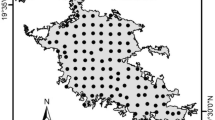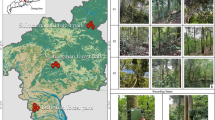Abstract
Anurans and birds rely on sound for a number of social behaviors. Species that use roadside habitats are exposed to traffic noise that can mask important social signals and directly affect the community diversity and composition. We evaluate the impact of traffic noise on anuran and bird species richness, species occurrence, and composition in Puerto Rico, where there is a high density of highways and cars that generate high levels of noise pollution. We compared paired forest sites near (100 m, n = 20, dB > 60) and far (>300 m, n = 20, dB < 60) from highways, with similar vegetation structure, but different levels of noise. We found that the anuran community was not affected by traffic noise. In contrast, bird species richness and occurrence were significantly lower in sites near the highway, and bird species composition also varied significantly. Bird species with low-frequency songs were only detected in sites far from highways. The differences in the ecology and communication behavior between anurans and birds could explain these results. Anurans mainly call at night, when traffic activity was low. In contrast, bird singing activity occurs during the day and overlaps with the high levels of traffic noise. In addition, in natural habitats, Puerto Rican anurans occur at high densities and form noisy choruses (>80 dB), which may allow them to tolerate high levels of anthropogenic noise.






Similar content being viewed by others
References
Acevedo MA, Restrepo C (2008) Land-cover and land-use change and its contribution to the large-scale organization of Puerto Rico’s bird assemblages. Diversity and Distributions 14:114–122
Acevedo MA, Villanueva-Rivera IJ (2006) Using automated digital recording systems as a effective tools for the monitoring of birds and amphibians. Wild Life Society Bulletin 34:211–214
Alicea-Pou J, Viñas-Curiel O, Cruz-Vizcarrondo W, Alomar O (2006) Monitoring of the environmental noise level in San Juan, Puerto Rico. Junta de Calidad Ambiental de Puerto Rico
Amézquita A, Höld W, Lima AP, Castellanos L, Erdtmann LK, Araújo MC (2006) Masking interference and the evolution of the acoustics communication system in the Amazonian dendrobatid frog Allobates femoralis. Evolution 60:1874–1887
Barber JR, Crooks KR, Fristrup KM (2010) The cost of chronic noise exposure for terrestrial organisms. Trends in Ecology and Evolution 25:180–189
Bee MA, Swanson EM (2007) Auditory masking of anuran advertisement calls by highway traffic noise. Animal Behaviour 74:1765–1776
Benitez-López A, Alkemade R, Verweij PA (2010) The impact of roads and other infrastructure on mammal and bird populations: a meta-analysis. Biological Conservation 143:1307–1316
Bergen F, Abs M (1997) Etho-ecological study of the singing activity of the blue tit Parus caeruleus, great tit Parus major and chaffinch Fringilla coelebs. Journal für Ornithologie 138:451–467
Berglund B, Lindvall T (1995) Community noise. Archives of the Center for Sensory Research 2:1–195
Bermúdez-Cuamatzin E, Ríos-Chelén AA, Gil D, Garcia CM (2009) Strategies of song adaptation to urban noise in the house finch: syllable pitch plasticity or differential syllable use. Behaviour 146:1269–1286
Boeckle M, Preininger D, Höld W (2009) Communication in noisy environments I: acoustic signals of Staurois latopalmatus Boulenger 1887. Herpetologica 65:154–165
Brumm H (2004) The impact of environmental noise on song amplitude in a territorial bird. Journal of Animal Ecology 73:434–440
Brumm H, Slabbekoorn H (2005) Acoustic communication in noise. Advances in Study of Behavior 35:151–209
Brumm H, Slater PJB (2006) Ambient noise, motor fatigue, and serial redundancy in chaffinch song. Behavior Ecology and Sociobiology 60:475–481
Brumm H, Schmidt R, Schrader L (2009) Noise-dependent vocal plasticity in domestic fowl. Animal Behavior 78:741–746
Departamento de Transportación y Obras Públicas de Puerto Rico DTOP (2009) http://www.dtop.gov.pr/
Dooling RJ, Popper A (2007) The effect of highway noise on birds. The California Department of Transportation Division of Environmental Analysis, Sacramento
Dorcas ME, Price SJ, Walls SC, Barichivich WJ (2009) Auditory monitoring of anuran populations. In: Dood CK Jr (ed) Amphibian ecology and conservation: a hand book of techniques. Oxford University Press, Oxford, pp 281–298
Eigenbrod F, Hecnar SJ, Fahrig L (2008) The relative effects of highway traffic and forest cover on anuran populations. Biological Conservation 141:35–46
Ewel JJ, Whitmore JL (1973) The ecological life zones of Puerto Rico and the U.S. Virgin Islands. Forest Service, U.S. Department of Agriculture. Institute of Tropical Forestry, Rio Piedras, Puerto Rico.
Forman RTT, Deblinger RD (2000) The ecological highway-effect zone of a Massachusetts U.S.A. suburban highway. Conservation Biology 14:36–46
Francis CD, Ortega CP, Cruz A (2009) Noise pollution changes avian communities and species interactions. Current Biology 19:1415–1419
Fuller RA, Warren PH, Gaston KJ (2007) Daytime noise predicts nocturnal singing in urban robins. Biology Letters 3:368–370
Gerhardt HC, Huber F (2002) Acoustic communication in insects and anurans: common problems and diverse solutions. University of Chicago Press, Chicago
Gould W, Alarcó C, Fevold B, Jiménez ME, Martinuzzi S, Potts G, Solórzano M, Ventosa E (2007) Puerto Rico Gap Analysis Project–Final Report. USGS, Moscow ID and the USDA FS International Institute of Tropical Forestry, Río Piedras, PR. 157 p and 8 appendices
Hoelzel AR (1986) Song characteristics and response to playback of male and female robins Erithacus rubecula. Ibis 128:115–127
Kaiser K, Hammers JL (2009) The effect of anthropogenic noise on male advertisement call rate in the neotropical treefrog, Dendropsophus triangulum. Behaviour 146:1053–1069
McCune B, Grace JB (2002) PC-ORD: multivariate analysis of ecological data. Version 5. User’s guide. MjM Software Design, Glendel Beach, Oregon
Myers N, Mittermeier RA, Mittermeier CG, da Fonseca GAB, Kent J (2000) Biodiversity hotspot for conservation priorities. Nature 403:853–858
Narins P (1995) Frog communication. Scientific American 273:62–67
National Oceanic and Atmospheric Administration NOOA (2010) http://www.weather.gov/climate/index.php?wfo=sju
Pardieck KL, Meyers JM, Pagán M (1996) Surveys of Puerto Rican Screech-Owl populations in large-tract and fragmented forest habitats. The Wilson Bulletin 108:776–782
Parris KM, Schneider A (2008) Impacts of traffic noise and traffic volume on birds of highway side habitats. Ecol Soc 14:29 http://www.ecologyandsociety.org/vol14/iss1/art29/
Parris KM, Velik-Lord M, North JMA (2009) Frogs call at a higher pitch in traffic noise. Ecol Soc 14:25 http://www.ecologyandsociety.org/vol14/iss1/art25/
Peris SJ, Pescador M (2004) Effects of traffic noise on passerine populations in Mediterranean wooded pastures. Applied Acoustics 65:357–366
Raffaele HA (1989) A guide to the birds of Puerto Rico and the Virgin Islands. Princeton University Press, Princeton, 254 p
Reijnen R, Foppen R, Ter Braak C, Thissen J (1995) The effects of car traffic on breeding bird populations in woodland. III. Reduction of density in relation to the proximity of main highways. Journal of Applied Ecology 32:187–202
Rheindt FE (2003) The impact of highways on birds: does song frequency play a role in determining susceptibility to noise pollution? Journal of Ornithology 114:295–306
Rivero JA (1998) Los anfibios y reptiles de Puerto Rico. Editorial de la Universidad de Puerto Rico. San Juan, Puerto Rico. 510 pp
Slabbekoorn H (2004) Habitat-dependent ambient noise: consistent spectral profiles in two African forest types. Journal of Acoustical Society of America 116:3727–3733
Slabbekoorn H, Peet M (2003) Birds sing at a higher pitch in urban noise. Nature 424:267
Slabbekoorn H, Ripmeester EAP (2008) Birdsong and anthropogenic noise: implications and applications for conservation. Molecular Ecology 17:72–83
Stewart MM, Woolbright LL (1996) Amphibians. In: Reagan DP, Waide RW (eds) The food web of a tropical rain forest. University of Chicago Press, Chicago, pp 273–320
Stone E (2000) Separating the noise from the noise: a finding in support of the ¨niche hypothesis¨, that birds are influenced by human-induced noise in natural habitats. Anthrozoos 13:225–231
Suarez-Rubio M, Thomlinson JR (2009) Landscape and patch-level factor influence bird communities in an urbanized tropical island. Biological Conservation 142:1311–1321
Sun JWC, Narins PM (2005) Anthropogenic sounds differentially affect de amphibian call rates. Biological Conservation 121:419–427
Warren PS, Katti M, Ermann M, Brazel A (2006) Urban bioacoustics: it’s not just noise. Animal Behaviour 71:491–502
Wood WE, Yezerinac SM (2006) Song sparrow Melospiza melodia song varies with urban noise. Auk 123:650–659
Wunderle JM, Diaz A, Velasquez I, Scharrón R (1987) Forest openings and the distribution of understory birds in a Puerto Rican rainforest. The Wilson Bulletin 99:22–37
Zimmerman GM, Goetz H, Mielke PW Jr (1985) Use of an improved statistical method for group comparisons to study effects of prairie fire. Ecology 66:606–611
Acknowledgements
We thank Laura May-Collado and Joseph Wunderle for their comments on the manuscript. We thank A.P. Valencia, C. Sanfiorenzo, A. Herrera-Montes, J. Figueroa, S.V. Ramirez, B. Hilje, J. Fonseca and C.A. Rodriguez for their help in the field. We thank C. Milan and the ARBIMON team for their advice with recorders and recording software analysis. We thank P. Rincon and the International Institute of Tropical Forestry (IITF), USDA Forest Service, Puerto Rico for their help with the map. The research was funded by National Science Foundation (BDI 0640143), Junta de Calidad Ambiental de Puerto Rico and Ford Motor Company. Finally, we appreciate the comments and suggestions of two anonymous reviewers and the Editor that helped us improve the manuscript.
Author information
Authors and Affiliations
Corresponding author
Electronic supplementary material
Below is the link to the electronic supplementary material.
Appendix 1
(DOC 74 kb)
Rights and permissions
About this article
Cite this article
Herrera-Montes, M.I., Aide, T.M. Impacts of traffic noise on anuran and bird communities. Urban Ecosyst 14, 415–427 (2011). https://doi.org/10.1007/s11252-011-0158-7
Published:
Issue Date:
DOI: https://doi.org/10.1007/s11252-011-0158-7




